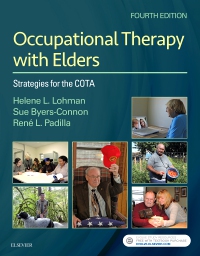
Occupational Therapy with Elders - Elsevier eBook on VitalSource, 4th Edition
Elsevier eBook on VitalSource

Now $72.89
Get the focused foundation you need to successfully work with older adults. Occupational Therapy with Elders: Strategies for the COTA, 4th Edition is the only comprehensive book on geriatric occupational therapy designed specifically for the certified occupational therapy assistant. It provides in-depth coverage of each aspect of geriatric practice — from wellness and prevention to death and dying. Expert authors Helene Lohman, Sue Byers-Connon, and René Padilla offer an unmatched discussion of diverse populations and the latest on geriatric policies and procedures in this fast-growing area of practice. You will come away with a strong foundation in aging trends and strategies for elder care in addition to having a deep understanding of emerging areas such as low-vision rehabilitation, driving and mobility issues, Alzheimer’s disease and other forms of dementia, new technological advancements, health literacy, public policy, dignity therapy, and more. Plus, you will benefit from 20 additional evidence briefs and numerous case studies to help apply all the information you learn to real-life practice. It’s the focused, evidence-based, and client-centered approach that every occupational therapy assistant needs to effectively care for today’s elder patients.
Newer Edition Available
Occupational Therapy with Older Adults - Elsevier eBook on VitalSource
-
- UNIQUE! Focus on the occupational therapy assistant highlights the importance of COTAs to the care of elder clients
- Unique! Attention to diverse populations and cultures demonstrates how to respect and care for clients of different backgrounds
- UNIQUE! Discussion of elder abuse, battered women, and literacy includes information on how the OTA can address these issues that are often overlooked
- User resources on Evolve feature learning activities to help you review what you have learned and assess your comprehension
- Case studies at the end of certain chapters illustrate principles and help you understand content as it relates to real-life situations
- Multidisciplinary approach demonstrates the importance of collaboration between the OT and OTA by highlighting the OTA’s role in caring for the elderly and how they work in conjunction with occupational therapists
- Key terms, chapter objectives, and review questions are found in each chapter to help identify what information is most important
-
- NEW! 20 Additional evidence briefs have been added to reinforce this book’s evidence-based client-centered approach
- NEW! Incorporation of EMR prevalence and telehealth as a diagnostic and monitoring tool have been added throughout this new edition
- NEW! Expanded content on mild cognitive impairment, health literacy, and chronic conditions have been incorporated throughout the book to reflect topical issues commonly faced by OTs and OTAs today
- NEW! Coverage of technological advancements has been incorporated in the chapter on sensory impairments
- NEW! Other updated content spans public policy, HIPAA, power of attorney, advanced directives, alternative treatment settings, dignity therapy, and validation of the end of life
- NEW! Merged chapters on vision and hearing impairments create one sensory chapter that offers a thorough background in both areas
-
Section One: Concepts of Aging
1. Aging trends and concepts
2. Biological and social theories of aging
3. The Aging process
4. Psychological aspects of aging
5. Aging well: health promotion and disease prevention
6. The regulation of public policy for elders
Section Two: Occupational Therapy Intervention with Elders
7. Occupational therapy practice models
8. Opportunities for best practice in various settings
9. Cultural diversity of the aging population
10. Ethical aspects in the work with elders
11. Working with families and caregivers of elders
12. Addressing sexual activity of elders
13. Use of medications by elders
14. Considerations of Mobility
Part 1: Restraint reduction
Part 2: Wheelchair seating and positioning
Part 3: Fall prevention
Part 4: Community mobility
15. Working with elders who have vision impairments
16. Working with elders who have hearing impairments
17. Strategies to maintain continence in elders
18. Dysphagia and other eating and nutritional concerns with elders
19. Working with elders who have had cerebrovascular accidents
20. Working with elders who have dementia and Alzheimer's disease
21. Working with elders who have psychiatric conditions
22. Working with elders who have orthopedic conditions
23. Working with elders who have cardiovascular conditions
24. Working with elders who have pulmonary conditions
25. Working with elders who have oncological conditions


 as described in our
as described in our 